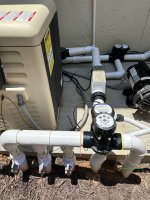- Jul 21, 2013
- 65,101
- Pool Size
- 35000
- Surface
- Plaster
- Chlorine
- Salt Water Generator
- SWG Type
- Pentair Intellichlor IC-60
You can position the INLET on the cap over any of the pipes when you install the cover.
It does not make a difference to the actuator.
It does not make a difference to the actuator.





